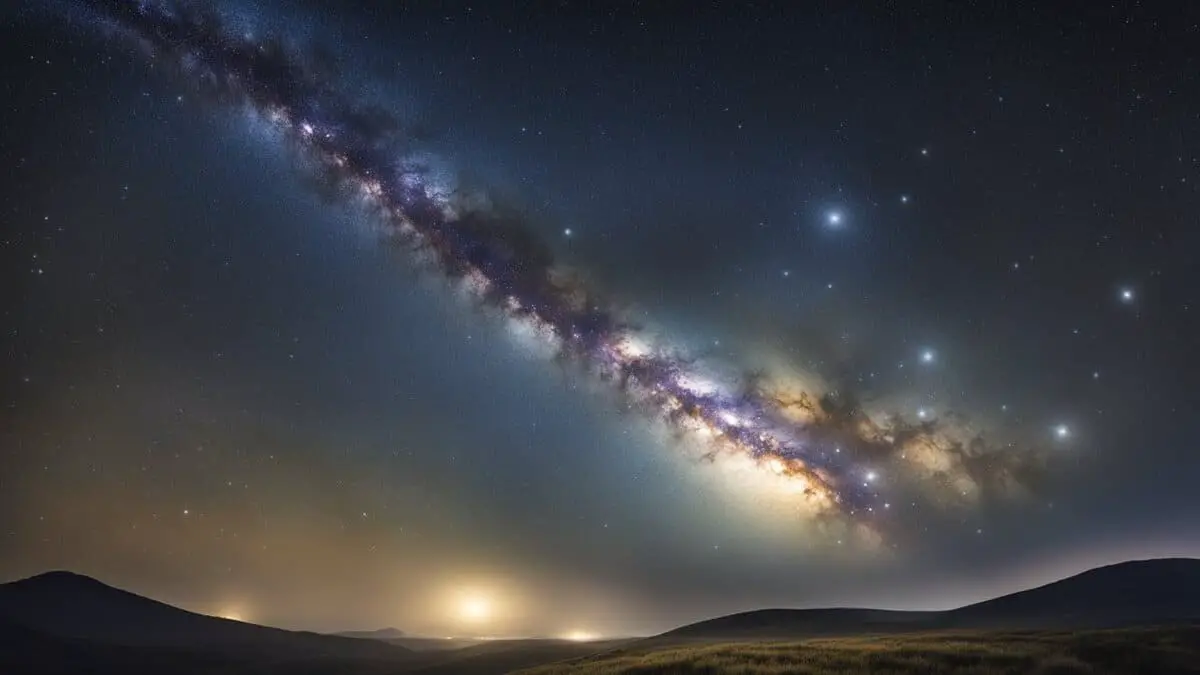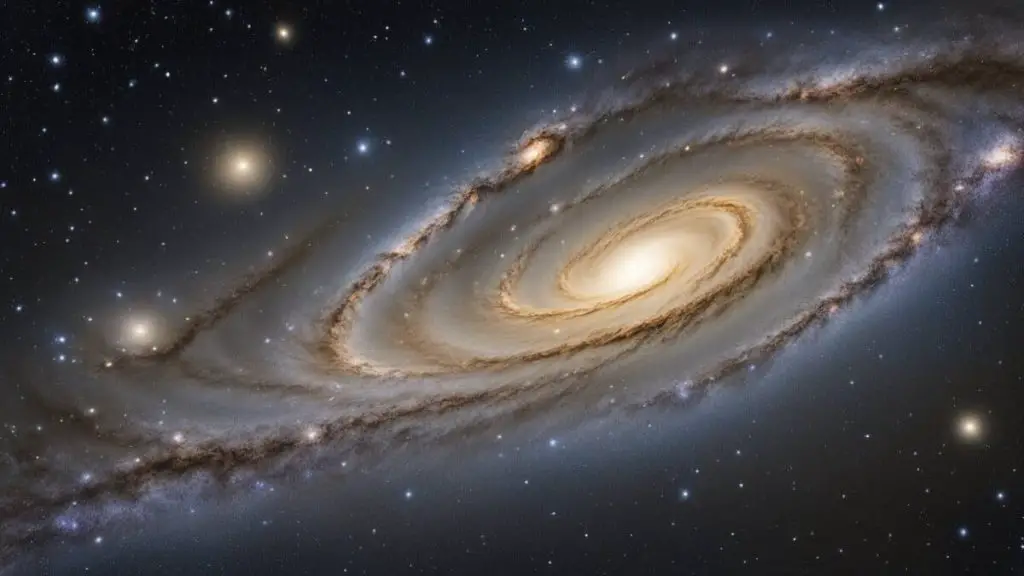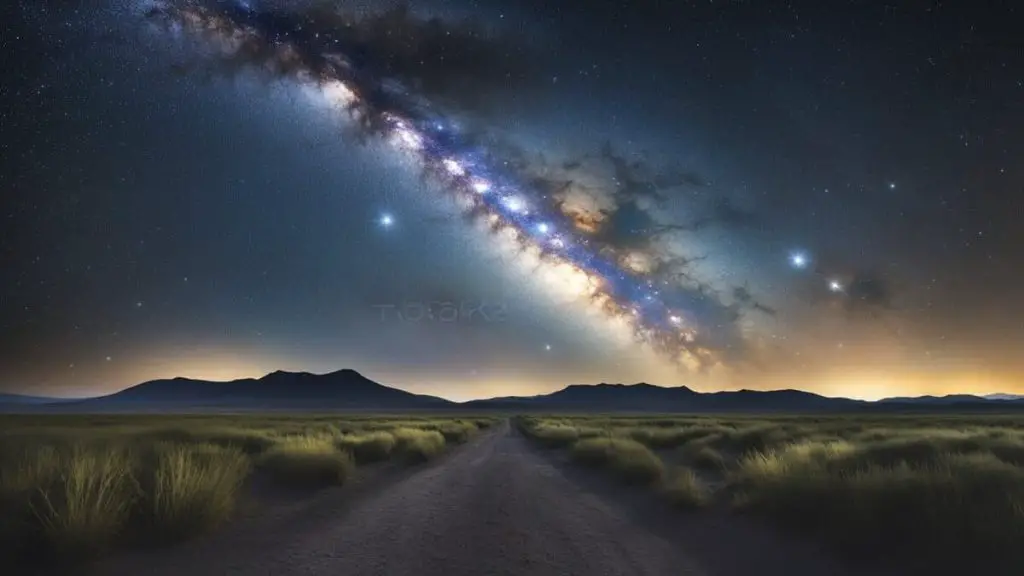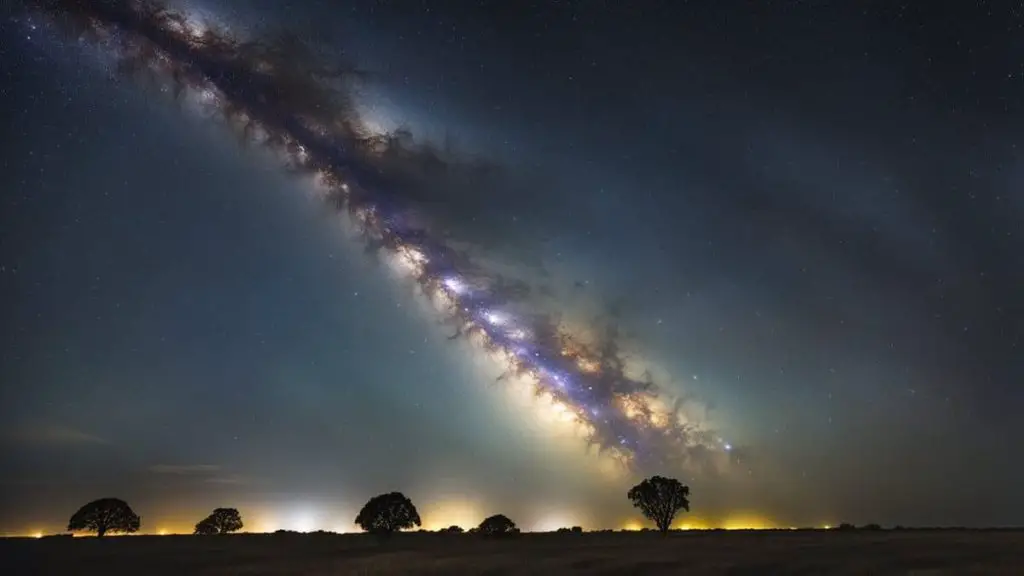The Milky Way often appears as a cloudy, mystical band when you look up at the night sky. This view has captivated stargazers for centuries, raising the question: why does it look so cloudy?
This cloudy appearance can be perplexing. It’s not immediately clear why a galaxy of stars, planets, and vast cosmic structures would appear like a soft, glowing cloud. This mystery might make the night sky seem even more distant and enigmatic.
In this article, I’ll guide you through the fascinating reasons behind the Milky Way’s cloudy appearance. You’ll discover how billions of stars, interstellar dust, and galactic dynamics create this stunning visual effect. Understanding these elements will make the night sky more familiar and awe-inspiring.
Key Things to Know
- The Milky Way’s cloudy look is due to billions of stars blending their light.
- Dust and gas in our galaxy alter starlight, contributing to the cloudy appearance.
- Our position inside the Milky Way limits our view of its entire structure.
- Best viewing conditions include dark skies and minimal light pollution.
Recommended For You
Overview: Why Does the Milky Way Look Cloudy

When you gaze up at the night sky and see the Milky Way, it looks like a cloudy strip stretching across.
In my own stargazing experiences, this view never fails to amaze me. This cloudy look is countless stars and other celestial stuff that’s too far to see clearly with just your eyes.
- Stars: In my observations, the billions of stars in the Milky Way blend their light, creating a soft glow rather than distinct points.
- Dust and Gas: These float around in space and can block or change the light from stars, giving the Milky Way its cloudy appearance.
In my studies, I’ve learned that astronomers classify the Milky Way as a barred-spiral galaxy, which means it’s like a whirling pinwheel in space.
We live inside this pinwheel, so seeing the whole shape is tough. Imagine being in the middle of a pancake; you can’t see the pancake’s shape, only the part close to you. That’s why you can’t see all the stars and the full spiral shape from where you stand.
So next time you’re stargazing, remember that the cloudy band you see is our home galaxy. And all the amazing things in it, like stars, planets, and space dust, make it look like a beautiful, blurry cloud.
FREE STARGAZING CHECKLIST
My 5-page Stargazing Checklist will enhance your astronomical observations.
Follow this free checklist to navigate the night sky with confidence, clarity, and a sense of preparedness for a rewarding stargazing experience.

Structure of the Milky Way

When you gaze at the night sky, you’re looking at the Milky Way, our home galaxy. It’s a vast city of stars, all held together by gravity.
Galactic Components
The Milky Way resembles a big family of stars, dust, and gas. This isn’t just a jumble; everything is organized.
- Disk: Most of the Milky Way’s stars, including our sun, live here. It’s like a flat, spinning plate.
- Halo: A spherical area that wraps around the disk. It has old clusters of stars.
- Bulge: The middle part, full of stars. Some are very old.
- Dark Matter: We can’t see it, but it’s out there, wrapping around the halo.
Spiral Arms Dynamics
Our Milky Way is a spiral galaxy. That means it has arms swirling around.
- The arms are made of more stars and hot gas.
- These arms spin around, but not too fast.
The Galactic Core
Right in the heart of the Milky Way is the galactic core. It’s a busy place.
- A supermassive black hole holds the core together.
- Around it, there’s a mix of gas and stars.
Observing the Milky Way

Observing the Milky Way has always been a thrilling experience for me. With the right conditions and tools, you can enjoy the details of our galaxy.
Visibility from Earth
To see the Milky Way, I always seek out a dark sky free of light pollution. The best time is on a clear night, away from city lights. Here’s what helps:
- Time of Year: Summer is excellent for viewing in the Northern Hemisphere.
- Moon Phase: New moon nights are perfect, as moonlight can dim the view.
- Location: Dark sky parks and rural areas offer the best visibility.
Telescopic Exploration
While I often view the Milky Way with the naked eye, using binoculars or a telescope always opens up a whole new world.
They allow you to see:
- Stars: Crisp, individual stars that are part of the Milky Way.
- Planets: Some planets can be seen as they move across our sky.
- Constellations: The patterns that have guided astronomers for centuries.
- Nebulae: Clouds of gas and dust where stars are born.
Remember to give your eyes time to adjust to the darkness for the best view.
Milky Way Composition and Characteristics

From my observations, the Milky Way appears cloudy due to its gas, dust, and star composition. Let’s look closer at what you’re seeing in the night sky.
Gaseous and Dust Elements
- Hydrogen gas and interstellar dust are the main ingredients that make the Milky Way look cloudy.
- Nebulas, which are large clouds of gas and dust, also add to the cloudy appearance.
Stellar Populations
- Our galaxy is full of stars, including the sun. You’re seeing all kinds of stars when you look up.
- There are groups of stars called globular clusters that orbit around the center.
- At the center, there’s a supermassive black hole, which is a pretty big deal even though you can’t see it.
Milky Way in the Larger Cosmos

In my astronomical journey, I’ve learned that the Milky Way is not alone in the cosmos; it’s part of a vast network of galaxies and cosmic structures. Understanding its place helps you grasp the larger picture of space.
Local Galactic Neighborhood
The Milky Way is a member of what astronomers call the Local Group. This is a collection of more than 50 galaxies that are gravity-bound to each other.
Along with the Milky Way, the Local Group contains:
- The Andromeda Galaxy, which is the closest spiral galaxy to us and is on a path to eventually collide with the Milky Way.
- The Small Magellanic Cloud and Sagittarius dwarf galaxies, which are some of the Milky Way’s closer neighbors.
Our home galaxy, the Milky Way, is a big part of the Local Group in terms of mass and gravitational influence.
Interactions with Other Galaxies
Galaxies don’t exist in isolation. They interact and sometimes even merge.
Here are a few key points about these cosmic interactions:
- Gravity is the force that guides these interactions. It can pull galaxies together, leading to collisions and, eventually, mergers.
- Collisions with other galaxies are a part of a galaxy’s life cycle. For example, the Milky Way and the Andromeda Galaxy are expected to collide in several billion years.
Such interactions are standard in the universe and a driving force behind the evolution of galaxies. They shape the structure and future of galaxies, including our own Milky Way.
Advanced Study and Discoveries

As we look up at the night sky, it’s clear that there’s more to the Milky Way than just a streak of light. Recent advancements in astronomy have shed light on why our galaxy appears cloudy.
Cutting-edge Research
Astronomers use powerful telescopes to study the Milky Way. They’ve found that the cloudiness is due to giant gas and dust clouds. These clouds are where new stars are born.
Here are some key details:
- Star Formation: New stars form within these clouds.
- Galactic Structure: Telescopes help map the spiral shape of our galaxy.
They also use space news updates from new rocket launches to understand better. Skywatching events often allow you to see these wonders yourself.
Black Holes and Galactic Evolution
At the center of the Milky Way is Sagittarius A*, a supermassive black hole. It plays a significant role in how our galaxy changes over time.
Here’s what you should know:
- Gravity’s Effect: The black hole’s gravity affects the whole galaxy.
- Monitoring Changes: As black holes pull in matter, they change, which helps astronomers learn.
In summary, the milky appearance of our galaxy is due to dust and star-forming activities, while black holes influence its evolution. Keep your eyes on the sky; you may see these phenomena yourself.
Frequently Asked Questions
Can I Photograph the Milky Way with Regular Camera Equipment?
Yes, you can photograph the Milky Way with regular camera equipment. With a DSLR camera, a tripod, and a long-exposure setting, you can capture stunning images of the Milky Way. The key is to find a dark location and use the proper settings.
How Does Light Pollution Affect Viewing the Milky Way?
Light pollution significantly affects viewing the Milky Way, as it dims the visibility of celestial objects. The Milky Way becomes almost invisible in areas with high light pollution, such as cities. Dark skies are essential for the best galactic viewing experience.
Are There Best Times of Year to View the Milky Way?
The best times of year to view the Milky Way vary depending on your location. In the Northern Hemisphere, summer months offer clearer views due to the galaxy’s position. Planning your stargazing around this time enhances your chances of a spectacular view.
TL;DR
- The Milky Way appears cloudy due to the blended light of billions of stars, interstellar gas and dust.
- Our position inside the Milky Way limits our ability to see its entire spiral structure.
- For optimal viewing, dark skies away from light pollution and at certain times of the year are best.
- Telescopes and binoculars can enhance the viewing experience, revealing more details of the galaxy.
- The Milky Way is part of a larger cosmic structure, interacting and evolving with other galaxies.
I’m always eager to expand my understanding and share insights about the wonders of our night sky.
I’d love to hear from you if you have any questions or thoughts or if there’s a specific aspect of astronomy you’re curious about.
Please leave your questions and comments below – let’s explore the cosmos together!
Read my other articles in my Milky Way series:
- Can You See the Milky Way with a Half Moon?
- How Many Solar Systems in the Milky Way?
- When is Milky Way Season?
- Are all the stars we see in the Milky Way?
- Does the Milky Way orbit anything?
- Are the constellations in the Milky Way?
- How are Milky Way pictures taken?
- Can you see the Milky Way with a full moon?
- Can you see the Milky Way on a cruise?
- Can I See the Milky Way with My Eyes?




